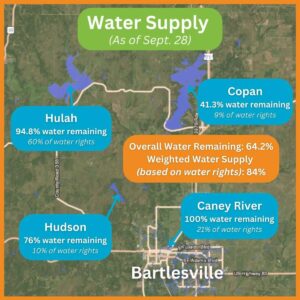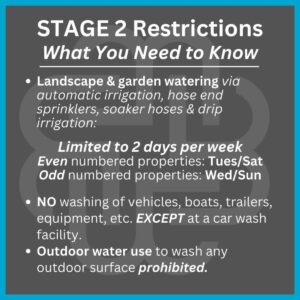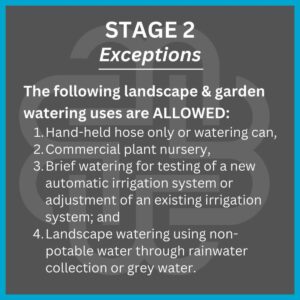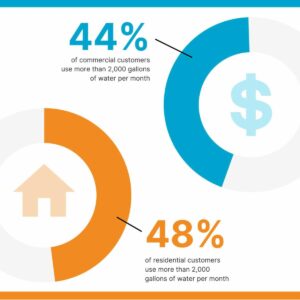City Council OKs modifications to Water Shortage Ordinance
 The City Council voted last week to follow the recommendations of the recently reconvened Water Resources Committee and approved modifications to the Water Shortage Ordinance, which serves as the City’s drought contingency plan.
The City Council voted last week to follow the recommendations of the recently reconvened Water Resources Committee and approved modifications to the Water Shortage Ordinance, which serves as the City’s drought contingency plan.
The committee has been tasked with looking at long-term water supply options and reviewing the ordinance, which was created following the 2001-02 drought and updated in April of this year.
The ordinance was put into effect for the first time in December 2022, when the City’s overall water supply fell below 80 percent. However, it was put “on hold” last month pending a review by the committee regarding the efficacy of the plan during the most recent drought, which is ongoing.
Committee members have met several times in recent weeks and have discussed at length items presented to them by City staff, including concerns expressed by the public regarding car washes being allowed to remain open during the height of the drought, the closure of City-owned swimming pools while privately-owned pools were allowed to remain open, and temporary emergency water rates, which appeared to be effective when first implemented but became less so once water customers realized the increases were not as significant as initially believed. During a meeting held last week, the WRC finalized its recommendations for council consideration.
Following a lengthy discussion on Monday, the council voted to approve the modified ordinance. Notable changes include:
- Water rights remaining at each of the City’s water supply sources will now be considered in addition to overall water remaining to determine stages of the ordinance. (See more information at the end of this article.)
- The city manager may now declare a drought stage based on the totality of information present at the time, i.e., rainfall projections, system outage, equipment failure, natural disaster, etc.
- Emergency water rates will no longer be imposed unless supply falls below acceptable levels and conservation efforts fail to lower consumption to goal level.
Ordinance less restrictive for most residential customers
“As we looked at who our largest users of water were during this drought, it became clear this was our larger commercial accounts, not residential,” said City Manager Mike Bailey.
“The modified ordinance includes much higher emergency water rate increases for customers using more than 100,000 gallons of water per month,” he said. “That is very high use. To put it in perspective, the average family uses about 7,000 gallons of water per month.”
Bailey said the committee discussed whether to single out high-use businesses, such as car washes, in the ordinance but decided it would likely be more legally sound to require any business using excessive volumes of water to pay the higher rates.
“Many of these changes are a direct result of the public input we received after the ordinance was implemented last December,” he said. “Car washes were certainly a part of that, as was the opening and/or closing of swimming pools.”
The modified ordinance closes all pools, public and private, in Stage 4 of the ordinance, or when water supply falls below 50 percent and the weighted water supply based on water right is less than 65 percent.
“Splash pads will be closed at Stage 2 because they use in one day what our pools use in a month,” Bailey said. “But pools will not be closed — and that includes the City-owned Frontier and Sooner pools — unless we are in an emergency situation, which is Stage 4 of the ordinance.
“For 98 percent of our residential water customers, this ordinance is less restrictive than it was before the modifications. Not only does it include exceptions for outdoor watering that weren’t there before, such as allowing watering with a handheld hose or watering can, and it provides that rate increases will only be imposed if consumption levels are not reached through other conservation methods.”
Rate increases drive consumption levels down
 The modified ordinance now takes consumption levels into consideration before temporary rate increases are imposed, giving consumers an opportunity to lower consumption before having to pay higher rates.
The modified ordinance now takes consumption levels into consideration before temporary rate increases are imposed, giving consumers an opportunity to lower consumption before having to pay higher rates.
“Previously, the City Council enacted the increases once water supply fell below a certain level, which also determined the stage of drought,” Bailey said. “We heard very clearly from the public on this issue, of course, as none of us wants to pay higher rates.
“But unfortunately, it was also very clear that rate increases had the most substantial effect in lowering consumption. Nothing else we did had anywhere close to the impact on conservation than imposing the temporary emergency rates.”
Bailey said that from Dec. 5, 2022, through April 3 of this year nearly every tool was used to communicate the status of the water supply and ask for conservation — social media, City Beat, utility bills, newspaper, radio and television.
“Unfortunately, these measures did not do much to reduce water consumption,” he said. “However, when the ordinance was modified in early April 2023 and the emergency water rates were implemented, consumption went down significantly.”
Emergency rates remained in effect moving to Stage 3 in May, until rains in mid-July allowed the emergency rates to be repealed.
Bailey said that following the billing cycle that included the emergency rates, consumption began to climb again.
“In the beginning, people were under the mistaken belief their water bills were going to double due to the emergency rates,” he said. “When it became apparent that wasn’t the case, they began to use more water again. It was obvious the increases were not high enough to prompt most people to conserve.”
At its lowest, consumption dipped down to just over 4 million gallons per day a few times since the drought began in December 2022, but on average it has remained well above 5 million gallons per day. Last week, consumption was 6.6 million gallons per day.
“There are now consumption goals in place for stages 2, 3 and 4, and the council will not be asked to consider rate increases unless these goals aren’t met,” Bailey said. “In Stage 2, the goal is 5.5 million gallons per day, Stage 3 is 4.74 million gallons per day, and Stage 4 is 4.25 million gallons per day. This allows us as a community to pull together, conserve water, and avoid emergency rates.”
Area currently in Stage 2
Stage 2 is in effect when overall water remaining is between 70 percent and 60 percent and the weighted water supply based on water right is below 85 percent.
With remaining water supply at 64.2 percent and remaining supply based on water rights at 84 percent, the City is in Stage 2 of the ordinance.
Under Stage 2 restrictions, landscape and garden watering through automatic irrigation systems, hose end sprinklers, soaker hoses and drip irrigation is restricted to two days per week. Even-numbered properties may water on Tuesdays and Saturdays, and odd-numbered properties may water on Wednesdays and Sundays.
Exceptions to this are landscape watering by means of hand-held hose only or watering can, commercial plant nursery, brief watering for testing of a new automatic irrigation system or after repair or adjustment of an existing irrigation system, landscape watering using non-potable water through rain water collection or grey water. (Grey water is relatively clean water from baths, showers, washing machines, sinks and other appliances.)
The stages
 Stage 1
Stage 1
Stage 1 of the ordinance will be in effect when overall water remaining is between 80 percent and 75 percent and the weighted water supply based on water right is below 95 percent. In this stage, the public will be informed and voluntary usage reduction will be requested.
If the overall water remaining is between 74.9 percent and 70 percent and the weighted water supply based on water right is below 95 percent, the following outdoor watering restrictions will be in effect:
Landscape and garden watering through automatic irrigation systems, hose end sprinklers, soaker hoses and drip irrigation are restricted to two days per week.
- Even numbered properties on Tuesdays and Saturdays.
- Odd numbered properties on Wednesdays and Sundays.
See exceptions above.
Stage 2
Stage 2 is in effect if overall water remaining is between 70 percent and 60 percent and the weighted water supply based on water right is below 85 percent.
- Outdoor watering schedule as defined in Stage 1.
- No washing of motor vehicle, motorbike, boat, trailer or other vehicle or piece of equipment except at a vehicle wash facility.
- Outdoor water use to wash any outdoor surface, including but not limited to sidewalks, walkways, driveways, parking lots, tennis and other sport courts, patios, decks or other paved or hard surfaced area is prohibited.
- Use of water to flush, test or disinfect new water lines or services or new wastewater facilities shall be prohibited, unless a variance is granted by the Water Utilities Director.
City-owned splash pads are already closed for the season, but this section of the ordinance would close them as well. Similarly, swimming pools are closed, but under Stage 2, City-owned swimming pools may implement a reduced schedule of operation or closure to conserve water.
The goal of the Stage 2 restrictions is to reduce water consumption to less than 5.5 million gallons per day. If the restrictions do not reduce water consumption below this threshold, the City Council may pass a resolution to enact the Stage 2 emergency water rates.
Stage 2 emergency rates:
- 0 to 2,000 gallons — No increase (most residential use)
- 2,000 to 10,000 gallons — No increase (large family, small commercial use)
- 10,001 to 25,000 gallons — 15 percent increase (higher-use commercial, irrigation, swimming pool)
- 25,001 to 50,000 gallons — 20 percent increase (high-use commercial)
- 50,001 to 100,000 gallons — 25 percent increase (very high-use commercial)
- 100,001 or more gallons — 50 percent increase (extremely high-use commercial, such as car washes)
Stage 3
Stage 3 will be in effect if the overall water remaining is between 60 percent and 50 percent and the weighted water supply based on water right is below 75 percent. Stage 3 restrictions are:
- Continue all actions in Stage 2 that are not altered by provisions in Stage 3.
- Landscape and garden watering through automatic irrigation systems, hose end sprinklers, soaker hoses and drip irrigation are restricted to one day per week. Even numbered properties may water on Saturdays, and odd numbered properties may water on Sundays. (The same exceptions listed in Stage 1 and Stage 2 apply.)
- Outdoor pools, hot tubs or spas may not be filled.
- Water pressure will be reduced within the distribution system to minimum levels allowed by state and federal regulations.
The goal of the Stage 3 restrictions is to reduce water consumption to less than 4.75 million gallons per day. If the restrictions do not reduce water consumption below this threshold, then the City Council may pass a resolution to enact the Stage 3 emergency water rates.
Stage 3 emergency rates:
- 0 to 2,000 gallons — No increase (most residential use)
- 2,000 to 10,000 gallons — 5 percent increase (large family, small commercial use)
- 10,001 to 25,000 gallons — 40 percent increase (higher-use commercial, irrigation, swimming pool)
- 25,001 to 50,000 gallons — 45 percent increase (high-use commercial)
- 50,001 to 100,000 gallons — 50 percent increase (very high-use commercial)
- 100,001 or more gallons — 75 percent increase (extremely high-use commercial, such as car washes)
 Stage 4
Stage 4
If the overall water remaining is below 50 percent and the weighted water supply based on water right is less than 65 percent, the City Council must declare an emergency.
Stage 4 restrictions:
- Continue all of the actions as directed in Stage 3 that are not altered by provisions in Stage 4.
- All outdoor landscape and garden watering is banned except when using non-potable water through rain water collection.
- All private and public pools must be closed. No water may be added to an indoor or outdoor pool or hot tub unless necessary to maintain the water purification system or to maintain the structural integrity of the pool or hot tub.
- Water may not be used in or related to a chemical lawn treatment.
The goal of the Stage 4 restrictions is to reduce water consumption to less than 4.25 million gallons per day. If the restrictions do not reduce water consumption below this threshold, the City Council may pass a resolution to enact the Stage 4 emergency water rates.
Stage 4 emergency water rates:
- 0 to 2,000 gallons — No increase (most residential use)
- 2,000 to 10,000 gallons — 10 percent increase (large family, small commercial use)
- 10,001 to 25,000 gallons — 60 percent increase (higher-use commercial, irrigation, swimming pool)
- 25,001 to 50,000 gallons — 65 percent increase (high-use commercial)
- 50,001 to 100,000 gallons — 70 percent increase (very high-use commercial)
- 100,001 or more gallons — 200 percent increase (extremely high-use commercial, such as car washes)
Without rain in Hulah Lake and/or Copan Lake watershed areas, located in Southeast Kansas, it is anticipated Bartlesville will enter Stage 4 in January 2024.
 Modifications to supply formula
Modifications to supply formula
The original ordinance determined stages based solely on remaining overall water supply and imposed emergency rates based on those percentages.
The modified ordinance outlines stages of outdoor water use restrictions based on remaining overall water supply and the weighted water supply based on water right.
This allows more weight to be given for water the City actually has access to rather than factoring in sources where little access is available.
“The threshold for each stage was modified to include the overall water remaining, which is the current measure for water supply, and water supply remaining based on water right,” Bailey said. “This accounts for the current water level disparity between Hulah and Copan Lake.”
Sixty percent of the City’s water comes from Hulah Lake, while only 9 percent comes from Copan and 10 percent from the City-owned Hudson Lake. Twenty-one percent comes from the Caney River.
“So while Copan levels are certainly relevant to our situation, remaining supply at Hulah Lake has a much higher impact on the water we actually have available for use,” Bailey said.




